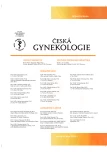Severe thrombotic microangiopathy accompanied by liver rupture and multiorgan failure at week 26 of pregnancy
Authors:
E. Magulová 1; J. Gumulec 2; E. Doležálková 3; P. Miřátská 3; M. Káňová 4; O. Šimetka 3
Authors‘ workplace:
Gynekologicko-porodnické oddělení, Nemocnice Nový Jičín, prim. MUDr. P. Bartoš, MMED., Ph. D.
1; Klinika hematoonkologie LF OU a FN, Ostrava, přednosta prof. MUDr. R. Hájek, DrSc.
2; Gynekologicko-porodnická klinika LF OU a FN, Ostrava, přednosta doc. MUDr. O. Šimetka, Ph. D.
3; Klinika anesteziologie, resuscitace a intenzivní medicíny FN, Ostrava, přednosta prof. MUDr. P. Ševčík, CSc.
4
Published in:
Ceska Gynekol 2020; 85(1): 30-34
Category:
Case Report
Overview
Objective: Case of a primigravid woman who suffered from severe PTMS (postpartum thrombotic microangiopathy syndrome) in the 26th week of pregnancy.
Design: Case report.
Setting: Department of Gynecology and Obstetrics, Hospital Nový Jičín; Department of Gynecology and Obstetrics, University Hospital Ostrava; Department of Hematooncology, University Hospital Ostrava; Department of Anaesthesiology and Resuscitation, University Hospital Ostrava.
Results: A thirty-one-year old primigravid woman was admitted to a secondary level institution due to epigastric pain and spontaneous rupture of membranes at 26th week of pregnancy. On admission her blood pressure was 140/90 mm Hg and an intrauterine fetal death was confirmed. The patient‘s condition deteriorated quickly, resulting in a hypertensive crisis (220/120 mm Hg), which did not respond to medication over a two hour period. Emergency caesarean section was performed, but the patient‘s condition progressed to HELLP syndrome class I, DIC and MOF. She was transferred to the intensive care unit (ICU) of the district referral hospital 38 hours postpartum.
On admission to ICU, liver rupture was diagnosed which was managed conservatively. Therapeutic plasma exchange (TPEX) was initiated on day 2 postpartum in response to falling platelets and continued for 6 days. Due to acute kidney injury (AKI), the patient required dialysis for 21 days. The patient‘s condition improved gradually and at 28 days after admission to ICU she was transferred back to the referring hospital. The consensus reached by the treating teams was that PTMS was the most likely diagnosis.
Conclusion: This case demonstrates that PTMS improves (usually rapidly) after TPEX is initiated. It also emphasises the importance of maintaining a high index of suspicion for PTMS so that life-saving TPEX can be initiated, because it does not respond to classical treat- ment used in the management of HELLP syndrome. Other research suggests patients may also require a terminal complement blockade with the anti-C5 monoclonal antibody (eculizumab). Further research could focus on diagnostic tests to distinguish PTMS from HELLP to identify which patients would most benefit from these treatments.
Keywords:
HELLP syndrome – thrombotic microangiopathy – atypical hemolytic uremic syndrome – plasma exchange – liver rupture – acute kidney failure – multiorgan dysfunction syndrome
Sources
l. Češka, R., Štulc, T., Tesař, V., Lukáš, M., et al. Interna. 2., aktualizované vydání. Praha: Stanislav Juhaňák, Triton, 2015.
2. Erkurt, MA., Berber, I., Berktas, HB., et al. A life-saving therapy in class I HELLP syndrome: Therapeutic plasma exchange. Transfus Apheresis Sci, 2015, 52(2), p. 194-198.
3. Gupta, M., Feinberg, BB., Burwick, RM. Thrombotic microangiopathies of pregnancy: Differential diagnosis. Pregn Hypertens, 2018, 12, p. 29–34.
4. Legendre, CM., Licht, C., Muus, P., et al. Terminal complement inhibitor eculizumab in atypical hemolytic-uremic syndrome. N Engl J Med, 2013, 368(23), p. 2169–2181.
5. Martin, JN., Files, JC., Blake, PG., et al. Postpartum plasma exchange for atypical preeclampsia-eclampsia as HELLP (hemolysis, elevated liver enzymes, and low platelets) syndrome. Am J Obstet Gynecol. Mississippi: Mosby-Year book, 1995, 172(4), p. 1107–1127.
6. Medhioub Kaaniche, F., Chaari, A., Turki, O., et al. Actualité sur le syndrome HELLP (Hemolysis, Elevated Liver enzymes and Low Platelets). La Revue de Médecine Interne. 2016, 37(6), p. 406–411.
7. Owens, MY., Martin, JN., Wallace, K., et al. Postpartum thrombotic microangiopathic syndrome. Transfus Apheresis Sci, 2013, 48(1), p. 51–57.
8. Vafaeimanesh, J., Nazari, A., Hosseinzadeh, F. Plasmapheresis: Lifesaving treatment in severe cases of HELLP syndrome. Caspian J Intern Med,. 2014, 5(4), p. 243–247.
9. Šimetka, O., Klát, J., Gumulec, J., et al. Early identification of women with HELLP syndrome who need plasma exchange after delivery. Transfus Apheresis Sci, 2014, 52, p. 54–59
10. Šimetka, O., Pařízek, A. HELLP syndrom. In: Kritické stavy v porodnictví. Praha: Galén, 2012, s. 75–78.
Labels
Paediatric gynaecology Gynaecology and obstetrics Reproduction medicineArticle was published in
Czech Gynaecology

2020 Issue 1
Most read in this issue
- Thrombotic microangiopathy and pregnancy
- Lactobacillus crispatus dominant vaginal microbita in pregnancy
- Noninvasive prenatal testing: benefits and limitations of the available tests
- Can we prevent ovarian cancer?
